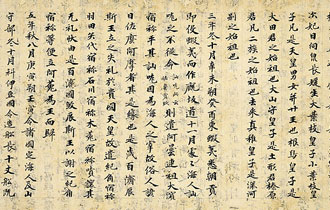Pages |
Many of the prints illustrate specific places, but there are also a number that illustrate symbols of a new and Westernized contemporary life, such as "Gas Station" of Fukazawa Sakuichi, a movie theater by Onchi Kōshirō, and, of particular interest, Henmi Takashi's print of the famous Imperial Hotel by the great American architect Frank Lloyd Wright, one of the few buildings to survive the 1923 earthquake. Another unusual print is Kawakami Sumio's rendering of a parade in which the young Emperor Hirohito (1901-1989) participated. At this point, Hirohito had only been Emperor for a half-dozen years or so following his return from England, where he had studied in 1921. At this time, he was still very much a public figure and had yet to assume the elevated, godlike stature of the later war years. The print thus serves as an unwitting record of a simpler time for the Imperial family in the course of modern Japanese history.
Among these artists, all of whom were quite gifted, there are several whose names are highly known and respected among the best artists of the period. Maekawa Senpan (1889-1960), the oldest of the group, was in his early forties when the project was completed. Originally trained as a Western-style oil painter, he had established a considerable reputation as a cartoonist and book illustrator.
His contributions to the set show his abilities to use flat spaces and elongated forms, giving his works a striking poster-like effect. Most important among his younger colleagues was Onchi Kōshirō (1891-1955). Also trained as an oil painter, Onchi began making prints, some of them abstract, that eventually earned him the reputation as Japan's most brilliant and innovating maker of prints in the twentieth century. In the New Tokyo series, Onchi's unusual juxtaposition of colors, striking sense of design, and brilliant texturing can be seen in such famous prints as his Tokyo Station and Inokashira Pond. Hiratsuka Un'ichi (1895-1997) studied with several important Western-style painters before becoming a printmaker himself. Now particularly admired for his postwar black-and-white prints, many of scenes in the United States, his prewar work shows a particularly elegant sense of color and design in works such as his Nihonbashi and Ueno Park. Others included, as mentioned above, were Henmi Takashi (1895-1944), Kawakami Sumio (1895-1972), Fukazawa Sakuichi (1896-1947), and Suwa Kanenori (1887-1932), all of whom earned popular and critical distinction during their careers.
Each of the eight artists represented in the New Tokyo series has a distinctive and easily-recognized style. Nevertheless, all worked together on the basis of their common ideals and belief in the value of sōsaku hanga. They managed to achieve a remarkable visual unity despite the fact that it took them four years to complete the series.
Perhaps the best way to grasp the range and significance of the series is to follow these artists around the city as they visited the main spots of interest to them in this huge and varied urban space.
Pages |











